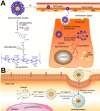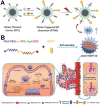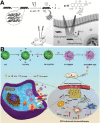Recent progress in nanomedicine for enhanced cancer chemotherapy
- PMID: 33995663
- PMCID: PMC8120226
- DOI: 10.7150/thno.57828
Recent progress in nanomedicine for enhanced cancer chemotherapy
Abstract
As one of the most important cancer treatment strategies, conventional chemotherapy has substantial side effects and leads easily to cancer treatment failure. Therefore, exploring and developing more efficient methods to enhance cancer chemotherapy is an urgently important problem that must be solved. With the development of nanotechnology, nanomedicine has showed a good application prospect in improving cancer chemotherapy. In this review, we aim to present a discussion on the significant research progress in nanomedicine for enhanced cancer chemotherapy. First, increased enrichment of drugs in tumor tissues relying on different targeting ligands and promoting tissue penetration are summarized. Second, specific subcellular organelle-targeted chemotherapy is discussed. Next, different combinational strategies to reverse multidrug resistance (MDR) and improve the effective intracellular concentration of therapeutics are discussed. Furthermore, the advantages of combination therapy for cancer treatment are emphasized. Finally, we discuss the major problems facing therapeutic nanomedicine for cancer chemotherapy, and propose possible future directions in this field.
Keywords: cancer therapy; chemotherapy; combination therapy; nanocarriers; nanomedicine.
© The author(s).
Conflict of interest statement
Competing Interests: The authors have declared that no competing interest exists.
Figures










References
-
- Gilman A. The initial clinical trial of nitrogen mustard. Am J Surg. 1963;105:574–8. - PubMed
-
- Qin S, Zhang A, Cheng S, Rong L, Zhang X. Drug self-delivery systems for cancer therapy. Biomaterials. 2017;112:234–47. - PubMed
-
- Penny LK, Wallace HM. The challenges for cancer chemoprevention. Chem Soc Rev. 2015;44:8836–47. - PubMed
-
- Bray F, Ferlay J, Soerjomataram I, Siegel RL, Torre LA, Jemal A. Global cancer statistics 2018: GLOBOCAN estimates of incidence and mortality worldwide for 36 cancers in 185 countries. CA: Cancer J Clin. 2018;68:394–424. - PubMed
-
- Qin S, Cheng Y, Lei Q, Zhang A, Zhang X. Combinational strategy for high-performance cancer chemotherapy. Biomaterials. 2018;171:178–97. - PubMed
Publication types
MeSH terms
Substances
LinkOut - more resources
Full Text Sources
Medical
Research Materials

